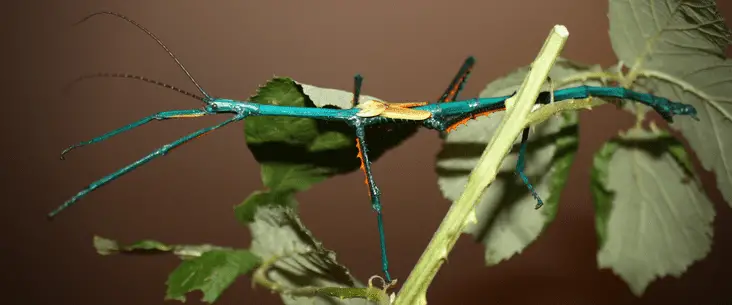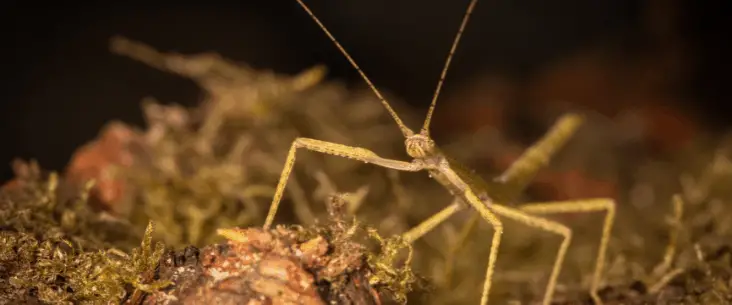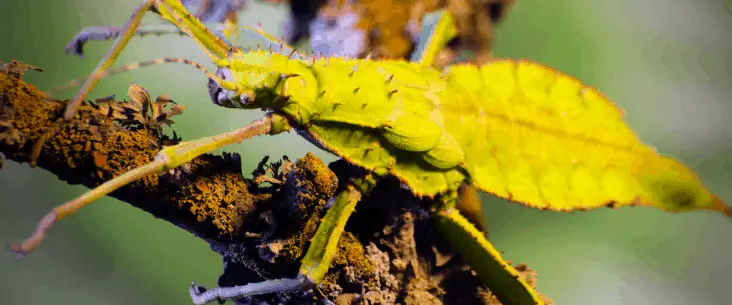The giant prickly stick insect (Extatosoma tiaratum) is one of the most popular stick insects kept as pets. This stick insect is pretty large and has beautiful camouflage which is typical for phasmids.
In this practical care guide, we will discuss how you take good care of your giant prickly stick insect. We will discuss housing, creating the correct environment, the best feeding practice and how to breed with them. But first, let’s talk more about this fantastic stick insect.
About the giant prickly stick insect

Appearance
As the name suggests, the giant prickly stick insect is covered with thorn-like spikes. It is served as camouflage and seems to scare off predators because these spikes do not hurt when handling this species. The thorn-like appendages are all over the body, including the legs and head. Males have fewer thorns on their bodies.
They are quite large too. Their long and thick body can grow up to 20cm (8″) long. Especially the females are more heavy-build compared to the slimmer males. The females have tiny wings and are not able to fly. The males have fully developed wings and can fly pretty good.
Their general colour range from light to mid-brown, but some individuals have a greenish glance, or are more beige or dark brown. The colour is depended on the condition you keep the stick insects, but till now there is no apparent relation to how the conditions influence the colour of their bodies. There is also a rare colour variant that looks like lichen called the ‘lichen-morph‘.
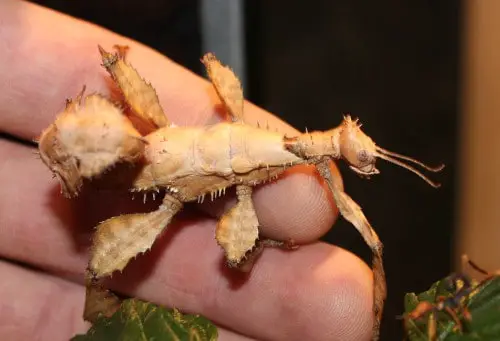
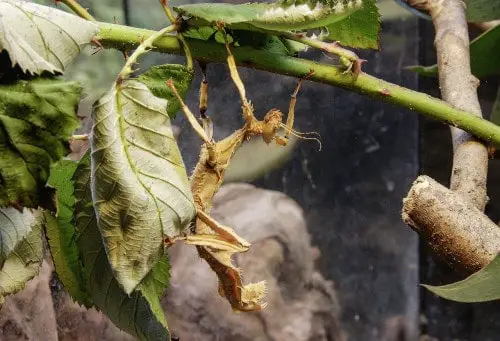
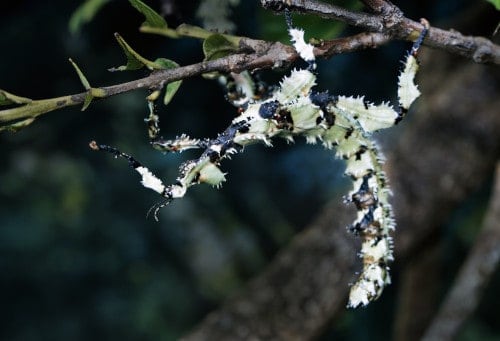
Behaviour, temperament and handling
Giant prickly stick insects are nocturnal and will move and eat mostly during dark hours, as most stick insects do. During the day they sit still or wave a bit as if they are caught by the wind. This is part of their defence mechanism where they mimic a stick or leave.
Giant prickly stick insects take camouflage even a bit further. One of their unique defensive strategies is when they are disturbed or threatened, they will adopt a threat pose where they curl up their abdomen and mimic a scorpion. This phenomenon is called mimicry. Predators will think twice before taking the risk of attacking a ‘scorpion’.
However, like most stick insects, giant prickly stick insects are very docile and can easily be handled. Unlike it seems they harm you with their thorns, they are unable to inflict any pain or injuries to humans. Be aware that even when they tolerate being handled, they don’t necessarily like it. Because they are quite fragile, you’ll need to be careful and make sure they don’t fall off your hand.
Housing requirements
The housing of spiny leaf insects is pretty easy. The enclosure should have a size of at least three times the body length in height (around 60cm / 23″) and two times to body length in width (around 40cm / 15″). Brands like ‘Exo Terra‘ and ‘Repti Zoo‘ make good enclosures suitable for this species. Instead of using a terrarium, you can also use a netting cage; however, you are better able to observe your stick insects in a terrarium. The size of your enclosure also depends on the number of animals you want to keep. The height is more important than the width of the enclosure.
The enclosure needs a fair amount of ventilation. When the enclosure lacks ventilation capacity, the humidity will build up and causes all kind of problems like mould and eventually the death of your animals. Additionally, when you have netting on the top of the enclosure makes it easy for these animals to moult.
You can use some branches and twigs as furniture for them to climb on. Branches and twigs also help the animals get from the bottom of the enclosure to the top. Don’t place too many twigs because they also need open space to do their moulting and there is also space needed to feed (see section: feeding practice). You can also use cork sheets on the side the make it easier for them to climb on.
These stick insects don’t need substrate specifically, but it helps with keeping the humidity at a stable level, and when animals fall, it doesn’t damage your animals. You can use different materials as a substrate, but personally, I prefer (aquarium/river) white sand or coconut fibre. You can also use other materials like leaves, potting soil and vermiculite, but these materials make it more challenging to find the eggs (see section: breeding tips).

Environmental conditions
These stick insects can be kept at room temperature. The recommended temperature range is between 20°C and 30°C (68°F – 86°F), preferably more on the higher end of the range. Night temperatures can drop to a minimum of 15°C (59°F). When the room you keep the animals in is lower than the recommended temperatures, you need additional heating. Heating can easily be done with a regular light bulb above the enclosure. A light cycle of 12h:12h works fine. It is sufficient if the room has natural light, and in this case, they don’t need any additional light source. However, never place the enclosure in direct sunlight because of the risk of overheating.
Spiny stick insects don’t have high demands on humidity. Room humidity (between 40% and 60%) works perfectly fine. When you use a heating source, you need to do more on keeping the humidity stable, because the heating source will dry out the enclosure. The substrate, as discussed earlier, will help keep the humidity at a stable level. It also helps by lightly misting the plants you feed your stick insects. If the enclosure is too dry, it will give problems with the moulting of the animals. On the other end, when it is too humid and wet will cause health issues and increase the risk of moult and bacteria growth in the enclosure.
Feeding practice
Spiny leaf insects are entirely herbivorous and only eat plants, specifically the leaves of plants. They only eat the leaves, but the stems and branches are used to climb and sit on. Sometimes they also use these branches to moult.
What to feed giant prickly stick insects
Their native food is the leaves of eucalyptus. However, there are more plants that they eat, and eucalyptus is not available in every country (or is really expensive). Suitable plants to feed Extatosoma tiaratum are blackberry (bramble), hawthorn, oak, raspberry, rose and hazel.
Blackberry/bramble will keep their leaves in the winter and is suitable to feed when other plants are not available. I gather leaves of these plants from around my neighbourhood and garden. When you buy one of these plants at garden centres, be aware that they might be sprayed with insecticides which will quickly kill your animals.

How to feed giant prickly stick insects
You can feed your spiny leaf insects by providing fresh leaves every two or three days. If the stick insects ate all leaves before that time, or when the leaves have dried out, you should refresh the leaves. When you collect the plants, cut pieces of the plant with stem and all (not only the leaves). Place the plant with its stem in a vase or bottle of water. This way, the plant will remain fresh longer. To make sure the vase/bottle doesn’t fall over, you can fill it with some small pebbles, sand or dig it into the substrate.
Stick insects also need some water to drink. Because a water bowl causes the risk of the drowning of animals (especially small nymphs), it is better to spray water on the leaves. So, before you place the leaves into the enclosure, mist them with a spraying bottle. Spraying the leaves also helps to prevent the leaves from drying out, and keeps them fresh for a longer time.
Cleaning routine
The cleaning of the enclosure is almost nothing and doesn’t cost much time. Most essential to do is remove old shed skins and old/dried leaves daily. Once every two or three weeks, you should do a more extensive cleanup by removing all the frass/droppings, refreshing (partly) the substrate and collecting eggs when you want to breed with them seriously. When you find a dead animal, inspect if you see something strange on the animal, and remove it from the enclosure. Things you need to check is the age of the dead animals and when they adult, if it is hurt or injured, and if you see any strange things like mould or pieces of old skin stuck to the animal.

Breeding tips
Recommended read: Basics of breeding phasmids
If you want to know all about breeding phasmids (stick insects and leaf insects) you should check out the helpful guide on how to breed phasmids. It discusses the basics, techniques and provides many practical tips.
I can imagine that you like to breed with your spiny leaf insects. At least, if you want to enjoy this species longer than 1,5 years. Giant prickly stick insects only get 18 months, at least that is the lifespan of females. Males will die earlier already and have a lifespan of around 6 to 8 months.
Extatosoma tiaratum is rather easy to breed. One particular amazing fact of this species is that they can reproduce without mating. This phenomenon is called parthenogenic which means that if you have only females, you still find fertile eggs. However, you have to be patient. Eggs that are laid from parthenogenic females will take up to 9 months before they hatch (and are all female clones). Eggs that are laid after mating will hatch around 4 months.
If you want to breed these stick insects seriously, you should collect the eggs and place them in a separate enclosure to incubate and hatch them. When you separate the eggs, it is easier to control and optimize the conditions to have the best breeding result and nymph survival rate.
Nymphs can be housed the same way the adults are housed, and nymphs can even be housed together with their adults. However, I can recommend hatching and raising nymphs separate from the adults for the first 2 stages of their life. Nymphs need higher humidity than adults to make moulting easier (a humidity around 60% to 70%).
The lichen colour morph that we talked about earlier is not happening only by genetics. The lichen morph is influenced by the environmental conditions wherein they hatch too. When you want to try to breed lichen morph giant prickly stick insects you need to raise nymphs from day one in an enclosure that is completely filled with lichen. This way some nymphs will moult into lichen colour morph nymphs as they take over that camouflage. If you separate these nymphs from the others and you only breed with these individuals, you will keep most often the lichen morph variants. However, some will be brown or greenish again, still.

Share this page!

